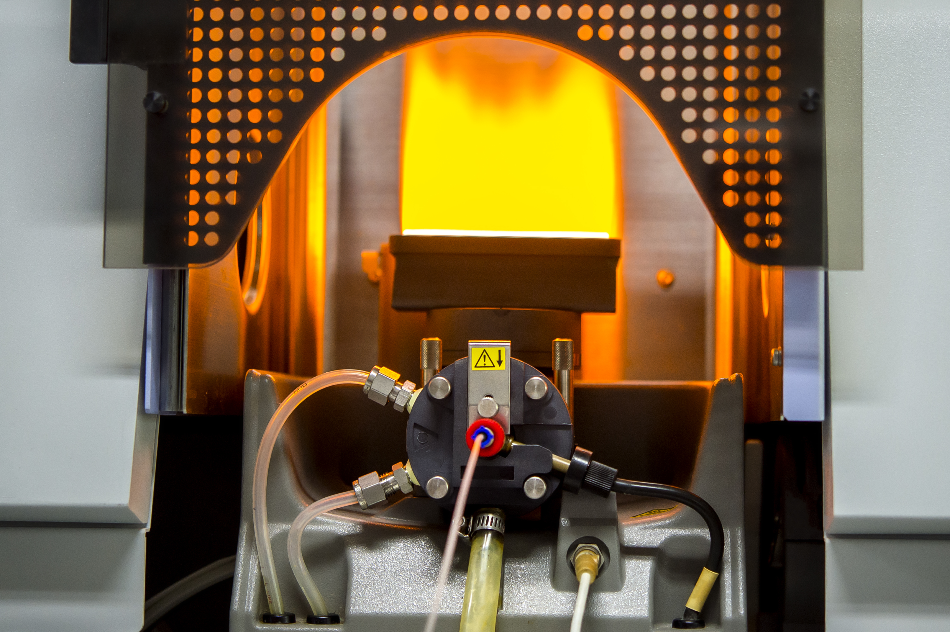
Image Credit: Rabbitmindphoto/Shutterstock.com
Atomic absorption is the process by which particles of matter (atoms) absorb energy. With 20th century advances in the field of physics, this process can be understood according to the peculiar laws of quantum mechanics. Our understanding of atomic absorption, which relies on quantum physics, has enabled the development of a minutely precise technique for recording information about a given material’s elemental composition: atomic absorption spectroscopy (AAS).
Light as a Wave and a Particle
Understanding of the nature of light was the first step towards understanding the makeup and behavior of the universe at its smallest possible interacting scale of size: the quantum scale.
Isaac Newton first proposed that light was composed of particles in 1670 after he observed the decomposition of white light from the sun into a spectrum of colors when it passed through a glass prism. This discovery began the scientific pursuit of spectroscopy, which is the study of how matter interacts with energy.
However, only 20 years later, in 1690, Christopher Huygens proposed a description of light as a series of waves traveling through the universe. Neither description of light energy could be refuted.
Finally, in the early 20th century, both descriptions of light were incorporated into one model. Physicists Max Planck, Albert Einstein, Ernest Rutherford, and Niels Bohr made a series of interventions that refuted the common-sense idea that the universe must operate according to the laws of classical mechanics that appear clear to any casual observer: one object cannot be two things at once, a piece of something cannot pass through something else without displacing it, objects can only be moved when they come into contact with other objects which impart their force onto them.
Through these advances, a theoretical framework was developed that allowed for such contradictory observations as the particle and wave descriptions of light to be understood. In the example of light energy, the theoretical proposals were backed up by experimentation. The now commonplace double-slit experiment shows how light is at once a particle and wave, explained by the quantum mechanical theory of superposition, and illustrated by the famous Schrödinger’s Cat thought experiment.
What are Atoms and Photons?
Atomic absorption can only be understood based on a quantum understanding of the smallest constituent parts of matter (atoms) and energy (particles that are also waves). Bohr enabled this understanding in 1913 when he proposed what is now referred to as the Bohr Model, which describes the minute structure of hydrogen atoms.
In the Bohr Model, hydrogen and all atoms of matter in the universe are comprised of a subatomic particle called a nucleus in the center, around which more subatomic particles called electrons cloud and spin in quantized orbits. The nature of an atom is determined by its number of electrons and the shape and speed of their orbits.
Light, and other forms of energy, are different from matter. A beam of light is composed of a wave that moves as a mathematical set of particles. These particles of light are called photons.
These descriptions of matter and energy are only understandable within the laws of quantum mechanics.
What is Atomic Absorption?
When photons of light are carried to atoms of matter along with the wave of light, these particles of energy are absorbed into the atom, passing through the cloud of electrons. However, this only happens if the energy levels of the photon and electrons are matched.
Almost immediately, the electrons that made way for the photon to be absorbed in the atom are drawn back to their nucleus due to electromagnetic force. When this happens, the related effect of atomic emission occurs, in which a photon is forced out of the atom.
The quantum mechanics involved in this phenomenon are best understood mathematically. In this way, the atom is described as an energetic system of particles that is trying to maintain its natural balance. The photon is absorbed and emitted as a part of this effort to maintain balance in the system.
References and Further Reading
Koirtyohann, S.R. (1991) A HISTORY OF ATOMIC ABSORPTION SPECTROMETRY. Analytical Chemistry, 63(21), pp.1024A-1031A. DOI:10.1021/ac00021a716
L’vov, B.V. (1990). Recent advances in absolute analysis by graphite furnace atomic absorption spectrometry. Spectrochimica Acta Part B: Atomic Spectroscopy, 45(7), pp.633–655. DOI:10.1016/0584-8547(90)80046-L
Disclaimer: The views expressed here are those of the author expressed in their private capacity and do not necessarily represent the views of AZoM.com Limited T/A AZoNetwork the owner and operator of this website. This disclaimer forms part of the Terms and conditions of use of this website.